Article Contents
- What Are Keywords in SEO
- Selecting Your Topic
- Use a Keywords Tool
- Consider Competition, Volume, and Intent
- Learn How to Use Your Keywords
__
Whether you are writing content or developing a general marketing strategy for your brand, choosing—and using—great keywords is vital to your company’s organic success on Google.
The development of the internet and search engines like Google have made marketers’ jobs significantly easier and more focused. While you used to have to guess what your target audience was looking for in a product or service, or conduct hours of market research using focus groups and case studies, you now have instant access to the world’s largest and smartest marketing database—Google.
What Are Keywords?
Keywords and keyphrases are the terms people (including your potential customers) type into search engines to find what they are looking for.
Keywords and keyphrases are the terms people (including your potential customers) enter into search engines to find what they are looking for. Discovering what those keywords are (and creating content on your website around them) is fundamental to connecting your brand with the people looking for what you offer. Without knowing what your target audience is searching for, you could be committing marketing treason!
Organic keywords are discovered through dedicated keyword research. Several great tools can help you find the right keywords for you to gear your content toward. We’ll include a list of some of those tools below as well as plenty of tips for finding the keywords that will bring more traffic, and ultimately more revenue, to your company.
Select Your Topic
Determining your topics is the first step to finding the right keywords for your website.
You know your brand inside and out and you generally know who buys your product or service.
For example, let’s say you are running a photography business. You can get a good starting point in your keyword research simply by thinking about what your clients are interested in. Potential topics might include wedding photography, family portraits, landscapes, etc. If you offer all those types of photos, you’ll want to organize the keywords you find into those topic groups. This will help you down the road to stay organized and rank with several different categories, all of which can lead to additional revenue.
Use a Keywords Tool
Now that you have your topics chosen, it’s time to start doing keyword research on each of your chosen topics you’d like to rank for.
Tools for Keywords
At Pouch, we use a myriad of tools to help find you the right keywords to track and use on your website. Some of the best tools to use are SEMrush, Google Search Console, Google Keyword Planner, and Google Trends. We’ll briefly go through how to use each program for your keyword research.
If you already have a live website, you can use Google Search Console to view what your existing pages are already ranking for. Navigate to “performance.”
Using Search Console, you can see what your pages are already ranking for. Navigate to “performance”.
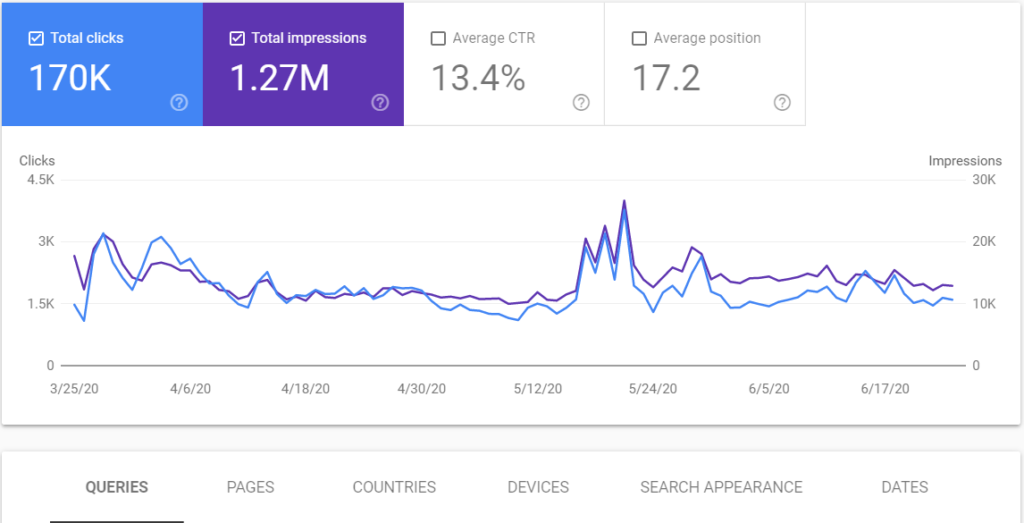
Scroll down to “queries” to see the terms your pages are ranking for in Google searches.

Here, Google reveals which terms your website shows up for, how many times in the given timeframe your site has shown up (measured by impressions), and the number of clicks in the timeframe your site received from users who searched that query.
In SEMrush, you can paste your URL into the top search bar and get a report that includes keywords you currently rank for. SEMrush is also great at coming up with new terms through the use of its Keyword Magic Tool. Start by typing in words you know you want to rank for and loads of related terms will generate, giving you data on each term!
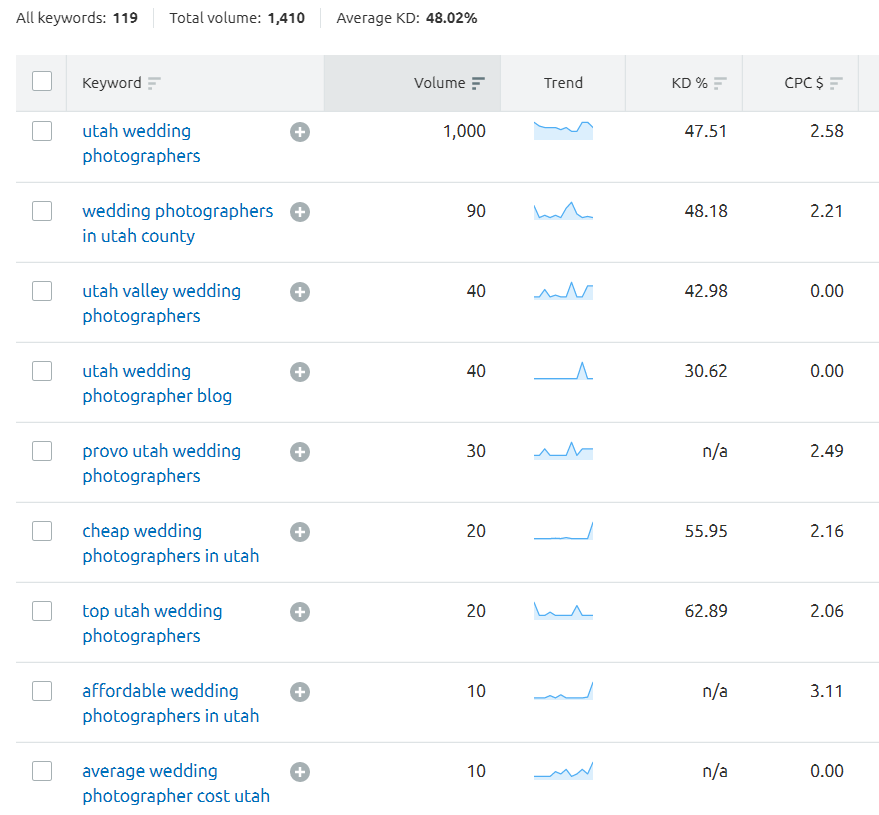
If you don’t want to or can’t pay for SEMrush, Google’s Keyword Planner can operate similarly to the Keyword Magic Tool. To use Keyword Planner, you do need to make an account with Google Ads, but you don’t have to actively be running a campaign to use this tool.
Start by typing in keywords you know you rank for or that you know you want to rank for.

Click “Get Results” and you will see metrics similar to those we mentioned from SEMrush! They should give you a good idea of which keywords are going to be harder to rank for and which you might be easier.
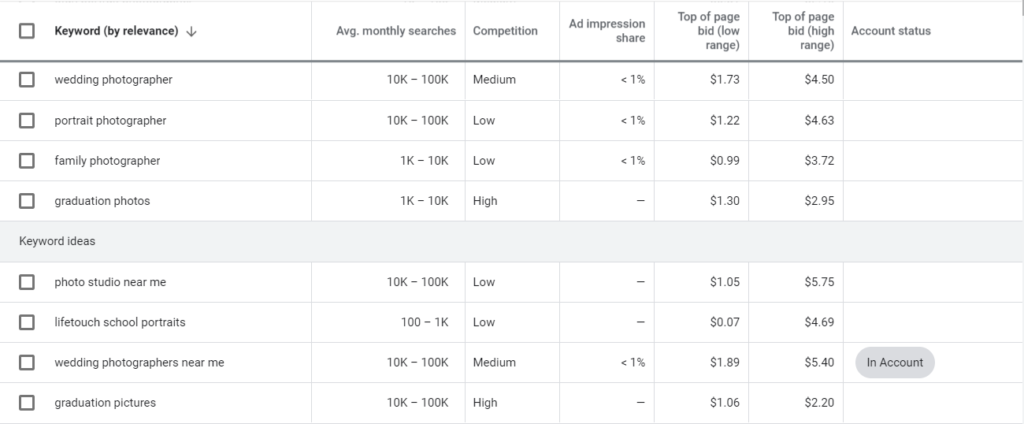
Google Trends is another great tool to use to analyze how timing and location affect searches related to your keyword. It is also helpful in comparing the popularity of two or more keywords against each other.
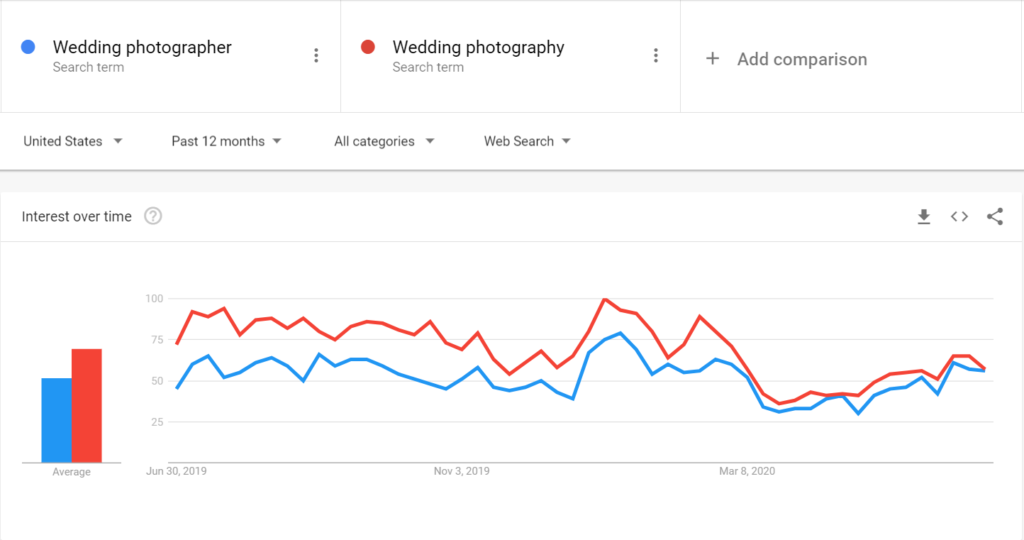
We also recommend using the “People also ask” box located right on your Google search results page. These are search terms Google considers related to your query. Each result here has some search volume (even if it is minimal).
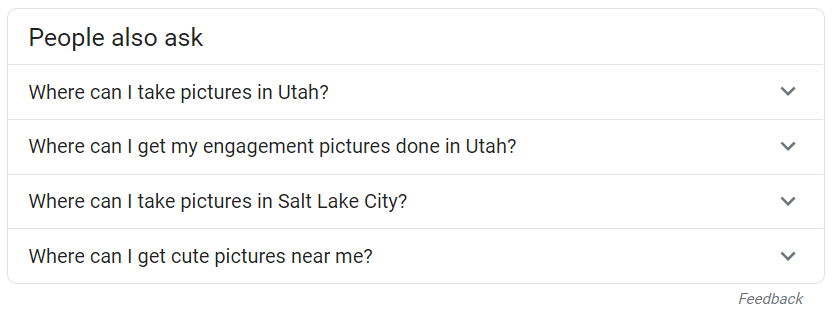
Subcategories
Next, you can organize the keywords you’d like to track into subcategories. “Priority” and “Content” are two we commonly use. It’s critical to differentiate between the two because while both will help you rank higher, priority keywords should directly lead to revenue while content raises overall brand awareness and domain authority through link acquisition.
In our photography example, the search “portrait photographer near me” is more of a priority term to target because the person searching is likely looking to make a purchase, whereas someone searching the term “photography tips” is not. You may, however, want to rank for both as both will lead to more traffic on your website, and in turn, you will rank higher than competitors.
Another important distinction to make—especially if you have a physical location—is localization. Localization refers to the fact that Google will give different results to an individual searching for something if they are searching from Orlando, Florida, vs. if they are searching from Salt Lake City, Utah. If you have a physical location like a studio, restaurant, or office space, you’ll want to organize key terms by those searched from your area and those that include your area in the search. We suggest tracking both types of searches.
You might also organize your keywords by “branded” terms, such as those related to your company name, and “non-branded” terms referring to the types of products/services you offer. You could also separate keywords by the individual products/services your company offers. Keyword organization can be divided up in the way that makes the most sense to you!
Consider Competition, Volume, and Intent
When considering all of the many keywords you might target, there are three very important factors to keep in mind:
- Competition
- Search Volume
- Intent
Choosing keywords that fit the right level of competition and volume searched will get you into the sweet spot of SEO where you can grow your website and gain revenue!
Competitiveness
The competitiveness of a keyword can be measured in several ways. The first is going to be what some SEO tools like SEMrush call “keyword difficulty.” This metric is a value describing how difficult it is to begin ranking for a particular term. Larger values probably mean that larger sites and a greater number of sites offer content fitting that query.
While metrics like this can be a helpful gauge, they should not be viewed as a hard and fast rule. If your priority keywords all have high competition or difficulty scores, you may still be able to rank in a top position. Search engines like Google are constantly reshuffling results pages to deliver the best results possible for users. If you are stuck trying to rank for a highly competitive keyword, reach out and we can help!
Volume
Search volume is the next key metric to take note of. Volume shows how many people on average are searching for that keyword in a given month.
This is key because while you may want to find a keyword with little competition, going too low can result in little-to-no search volume to match. For example, ranking number one for “glamorous photography of yellow pencils in Salem, Utah” will do you no good because no one has searched for that. Ever.
Intent
Intent is the final factor to include when analyzing your list of keywords. Prioritize keywords that users with a higher likelihood of conversion will search. While some broad terms like “funny photos” might get thousands of searches each month, it is unlikely that someone searching for that term is looking to hire a photographer. The term “Utah graduation photographer” shows intent to make a purchase and is a term you could track and target.
Similarly, the keywords you target in articles and resources on your site should be related to a step in your buyer’s journey. “Wedding planning checklist” may not show intent to purchase a photography package but may still be a good keyword to target based on where the user is at in the buyer’s journey.
Note: Keyword research tools like SEMrush may now offer an intent feature to help sort through transactional vs. informational terms. These features can help gather the right keywords quickly but should not be viewed as entirely authoritative. Most keywords today have mixed intent, meaning some users are looking for information, some are comparing brands, and some are looking to make a purchase. For these types of queries, the search engine will likely show a mix of different results (an e-commerce collection page, a comparison site, and a blog article about product features).
Your best bet to determine a keyword’s intent is to enter it into Google and examine the types of pages that are listed. If you’re having trouble ranking your product page, consider targeting the keyword with an informative article or a YouTube video.
Long-Tail Keywords
Finding the right combination of competitiveness, volume, and intent typically results in what SEOs call “long-tail keywords.” Long-tail refers to the longer, less-popular terms that can be depicted on a bar graph. These will generally be easier to rank for, whereas shorter-tail keywords that are searched at a higher rate might be near impossible for a small startup to initially rank for. Longer-tail keywords tend to be more specific, whereas shorter-tail terms are broader.
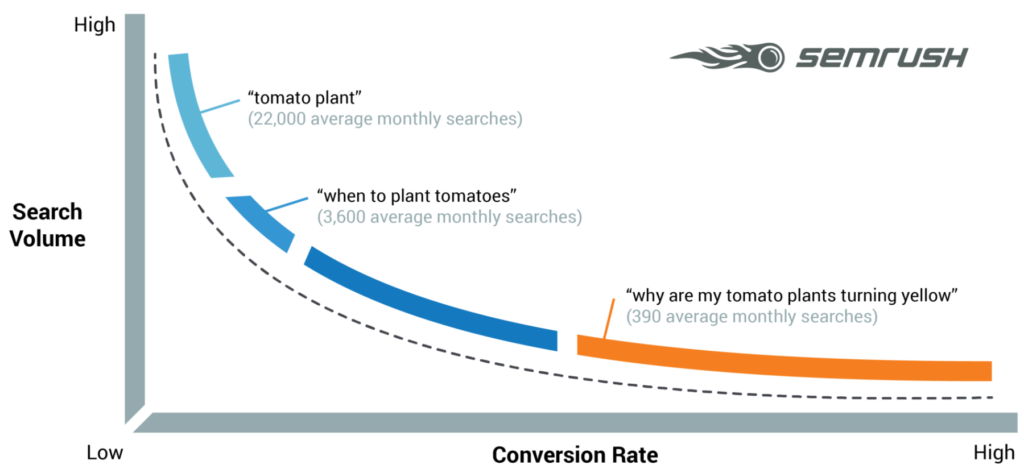
Again, the short-tail vs. long-tail keywords should be used only as a rough guide. Many long-tail keywords with high buyer intent can be extremely competitive and harder to rank for. Examining the current-ranking competitors for each keyword should tell you more about the difficulty than the total number of words in the query.
How to Use Your Keywords
Now that you have a working list of quality long-tail keywords, you need to know how to use them to make you more revenue!
In the past, SEOs might have recommended that you cram your web page with keywords in every heading and paragraph. Even if this brought modest success in the past, it no longer works. In fact, if you create poor content that is over-the-top and rich with keywords, Google will penalize you.
Instead, use your research to custom-build quality content on your pages that directly answer questions your potential customers are asking, and do it better than anyone else! Ranking higher on Google does require a lot of hard work and patience. Choosing great keywords that are targeted toward your audience makes the work you do more meaningful and productive.
Here at Pouch, we’d love to start helping you find, target, and track the keywords that will bring your business the traffic and revenue you are looking for. Reach out today!
Icons Courtesy of Freepik
Author

Josh Drebot
Marketing Specialist









